What Do Butterfly Eggs Look Like? 15 Common Butterfly Eggs
It is usually quite difficult to spot butterfly eggs if you are inexperienced or without the necessary tools because the green-yellow and even white shades make butterfly eggs look like they are blending into the leaves.
However, it is all for the survival rate of the caterpillars and larvae.
The shape of butterfly eggs can vary from spherical to pod-shaped or oval. They can also be laid in clusters or singly, depending on the habitat of the species.
The eggs more or less have a texture you can’t detect with your naked eye. These patterns can be micropiles (receptacles of sperm) or aeropyles (tubes for breathing).
What you will learn after reading this article:
- How butterfly eggs look like
- How to identify the eggs of 15 common butterfly species
15 Common Butterfly Eggs To Identify
Acmon Blue Butterfly Eggs
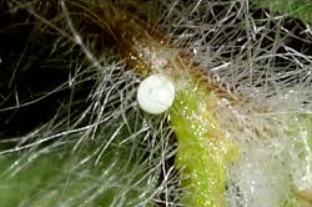
- Description: Single-laid eggs with a faint green color. When the larvae come out, the ants will tend to them while they feed on the host plants.
- Where: Buckwheats, trefoils, milkvetches, and lupines are all good for newborn caterpillars. The underside of the leaves is the female butterfly’s favorite spot to lay her eggs.
- Hatching period: They don’t stray away from the standard 1 – 2 weeks, and the cozy season from April to September.
Love butterflies, check now: Butterfly Rings & Butterfly Earrings
Brimstone Butterfly Eggs
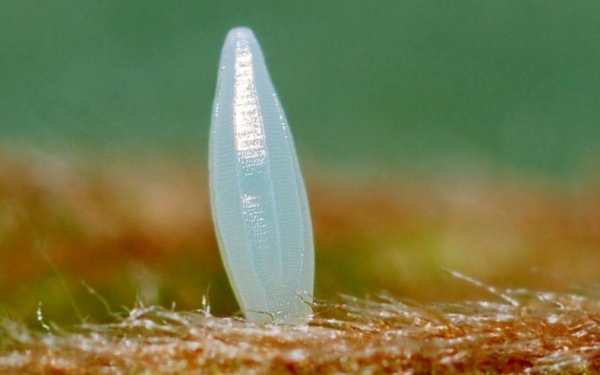
- Description: The eggs are pale green at first and fade into yellow then gray throughout the larva’s growth. If you find a cluster of Brimstone eggs, it is likely to be the work of many female butterflies or one female individual re-visiting one spot many times.
- Where: They are separated eggs on the underside of the newest buckthorn leaves. How high the leaves are on the plant doesn’t matter.
- Hatching period: The eggs will hatch within 1 – 2 weeks, most likely in May and June.
Cabbage White Butterfly Eggs
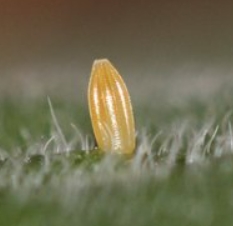
- Description: The eggs are oval with a golden color. With magnifying glasses, you might even detect a glittery glow on them. As the larva grows, it will add a shade of green to the egg.
- Where: Mustards are the first choice for these butterflies (cauliflower, broccoli, and, of course, cabbage), yet they can also benefit from weed plants such as London rocket, whitetop, or Flixweed. The leaves are considered the best spot for eggs, so the caterpillars can feed off them.
- Hatching period: 1 – 2 weeks is the normal required time for these eggs to hatch, though the cabbage white butterflies slow down so much during winter.
Check more: 7 Facts About The Smallest Butterfly In The World
California Sister Butterfly Eggs

- Description: The California Sister eggs are laid separately, with a green color that is probably too difficult for human eyes to detect. With tools, you can spot the texture of the eggs as well as the delicate fur-like layer.
- Where: These eggs are often laid on oak plants, especially on the upper surface of the leaves.
- Hatching period: The eggs will hatch after 11 days at most before the other instars take place.
Common Wood-Nymph Butterfly Eggs

- Description: Unlike the most frequently seen colors we have mentioned, the eggs of Common Wood-Nymph butterflies adorn a faded yellow shade that slowly turns into a tanned pink or orange.
- Where: These butterflies prefer a variety of grasses such as beard grass, Kentucky bluegrass, or poverty oatgrass.
- Hatching period: 1 – 2 weeks, depending on the temperature.
Large White Butterfly Eggs
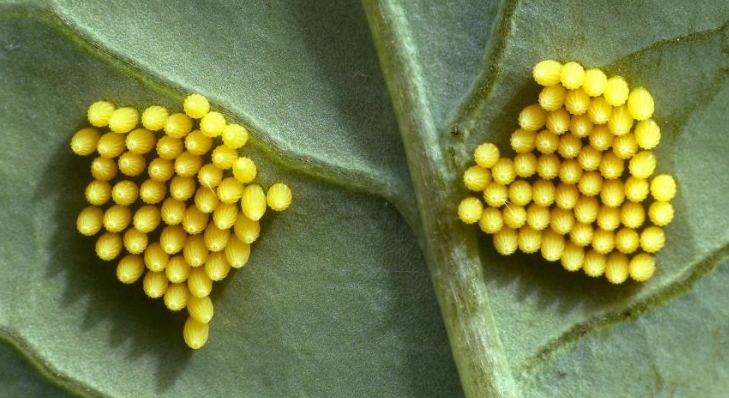
- Description: These eggs are shaped like Skittles with a bright yellow shade. Rather than being left on their own, they are laid in clusters and adhered to by a special substance from the mother’s body.
- Where: You have a better chance of spotting them beneath the leaves of wild mignotte, brassicas, or nasturtiums.
- Hatching period: The eggs hatch within 1 – 2 weeks, and their favorable weather ranges quite broadly from May to September.
Read more: Do Butterflies Lay Eggs?
Marine Blue Butterfly Eggs

- Description: The eggs are in a common light green shade and gradually turn white. The disc or oval shape along with the textured surface set it apart from other butterfly eggs. You can observe the pattern with tools because they are laid singly.
- Where: The South African Blue Plumbago shrub is the best place to look for it. They are tended to by the ants in western regions.
- Hatching period: Eggs hatch within 2 weeks at most.
Monarch Butterfly Eggs
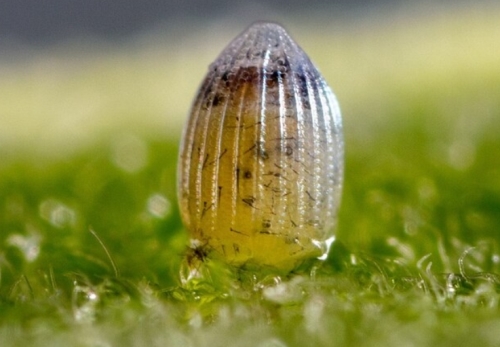
- Description: Monarch butterfly eggs might be the most beautiful eggs you will come across, with a glittery yellow shade and patterns running vertically.
- Where: They can be seen around the middle leaf of the milkweed plants, specifically the tip with white dots.
- Hatching period: 3 – 4 days, which is quite fast compared to many other species.
Mourning Cloak Butterfly Eggs

- Description: These heptagonal star-shaped eggs will easily convince you that they are a decorative item! They also have white lines running down to further emphasize the pretty golden color, yet it will darken into black before the eggs hatch.
- Where: They are in clusters on the leaves and stems of the food plants, including willow, wild rose, hawthorn, hackberry, Betula species, and more.
- Hatching period: About 2 weeks, but it can also be sooner.
Orange-Tip Butterfly Eggs
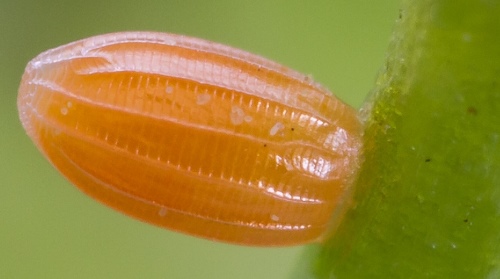
- Description: The transformation is quite magnificent as the eggs are laid singly, first faded green or greenish white. The larvae are bright orange, and that color will gradually come into sight.
- Where: In natural scenes, you can check the stalk or the calyx of garlic mustard or cuckooflower. for these eggs. If you are visiting a garden, try Dame’s Violet!
- Hatching period: The eggs favor warm but not too hot weather from April – June, and they can hatch after 1- 2 weeks at most.
Painted Lady Butterfly Eggs

- Description: They have a similar shape to the Mourning Cloak, yet the green color also makes them look more like a bean than an egg and is certainly hard to detect.
- Where: Their food plants include thistles (England and neighboring countries), Viber’s bugloss, and Common Nettle.
- Hatching period: 1 – 2 weeks, mostly in May – October with warm weather conditions.
Queen Butterfly Eggs
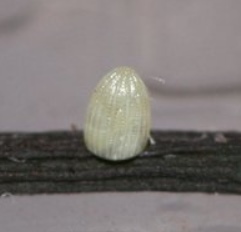
- Description: The eggs are laid separately, adopting a conical or oval form. The patterns observed on the surface are quite intricate.
- Where: You can find these eggs on flower buds, stems, and leaves of the host plant – basically everywhere! Their main host plant is milkweed.
- Hatching period: After 1 – 2 weeks, the eggs will hatch into one of the most striking caterpillars you will ever encounter!
Small Copper Butterfly Eggs

- Description: The slightly textured surface makes these eggs look like golf balls instead of smooth spheres. The female butterflies will lay white single eggs, which change to grey as the larvae grow some more.
- Where: Dock leaves, sheep sorrel, or leaf midrib are favorable, especially the underside of leaves.
- Hatching period: The eggs take 1 – 2 weeks to hatch. They favor the warm temperatures from May to August when the weather is almost hot for us.
Speckled Wood Butterfly Eggs
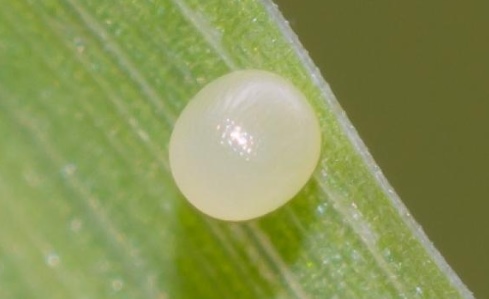
- Description: The eggs resemble spheres with a very light green shade. They are laid separately, hence you need to keep your eyes out for tiny little dots.
- Where: These butterflies favor grasses, including Yorkshire fog, false brome, and the like, especially when they are in sheltered and cozy places. The underside of the leaves is also the best choice for them to stay safe.
- Hatching period: This species relies on the weather tremendously, though it will take 1 – 3 weeks in warm seasons from April to August.
Swallowtail Butterfly Eggs
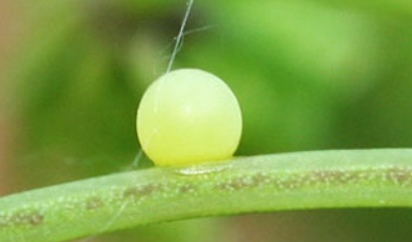
- Description: The newly laid eggs are spherical and yellow. As they grow, they will gradually turn brown and clear. Before they hatch, the shells are opalescent and truly pretty.
- Where: This species favors the carrot family plants. Case, parsley, and fennel are all likely for them to lay their eggs.
- Hatching period: The eggs will take no longer than 2 weeks to hatch.
The Takeaways
Learning these unique features means you know how to identify butterfly eggs correctly.
To search for butterfly eggs, you will need a camera with a macro function, a magnifying glass, notebooks, and pens.
You can start from the underside of the leaves, where female butterflies often feel safe to lay their eggs. Even though the upper side and the stems might be simpler to access.
If you have tried hunting for butterfly eggs before, please also share your experience and knowledge with us all. It will be highly appreciated!

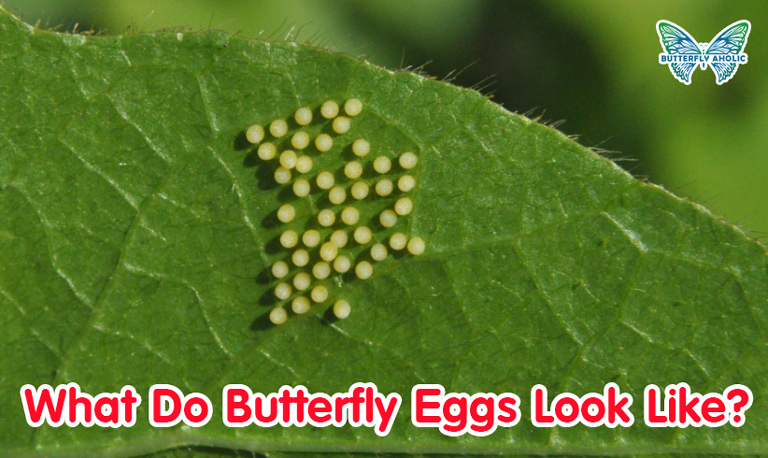
Really enjoyed seeing your butterfly egg photos. I look forward to reading and seeing what other information you can give me on the collection and looking after the eggs through to releasing the butterfly’s that I am trying to protect.
found almost a dozen black swallowtail baby caterpillars in my 1 parsley plant & lucky enough to also find one of their newly laid eggs.